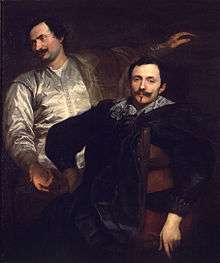Lucas de Wael
| Lucas de Wael | |
|---|---|
 Portrait of the brothers Lucas and Cornelius de Wael by Anthony van Dyck. | |
| Born |
Lucas de Wael 3 March 1591 Antwerp |
| Died |
25 October 1661 (aged 70) Antwerp |
| Nationality | Flemish |
| Known for | Painting, Engraving |
| Movement | Baroque |
Lucas de Wael (3 March 1591 – 25 October 1661) was a Flemish painter, engraver and merchant. He was born in Antwerp and worked for some time in Genoa in Italy before returning to Antwerp, where he died.
Life
Lucas de Wael was born into an artistic family in Antwerp as the son of the painter Jan de Wael I (1558-1633). His mother Gertrude de Jode came from a family of artists: her father was the cartographer Gerard de Jode and her brother was the engraver Peter de Jode I. He first studied with his father and was then a pupil of Jan Brueghel the Elder.[1]
Lucas possibly travelled to France at a young age. His younger brother, Cornelis de Wael (1592–1672), accompanied him when he travelled to Italy where, after a brief period in Rome, they settled in Genoa.[2]
Genoa was at the time an attractive destination for artists since the competition between artists there was less intense than in the leading cultural centres Rome, Florence and Venice, while Genoa was a thriving port city where a large number of potential patrons and collectors lived.[3]
The workshop of the brothers de Wael in Genoa became the centre of the colony of Flemish artists who resided in or passed through the city. These Flemish artists could take advantage of the work and artistic activity that the workshop of de Wael brothers attracted. The brothers provided a home, materials and tools, they assisted their compatriots with their local integration, passed on recommendations to clients and formulated competition rules. When Anthony van Dyck visited Genoa, he stayed with the brothers and Cornelis was one of his closest collaborators in the city.[4] Van Dyck painted a portrait of the brothers that was later engraved by Wenceslas Hollar. The brothers were also involved in trading activities with their hometown dealing in a wide variety of goods. Lucas returned to Antwerp in 1628 and played a major role in these business activities with his brother Cornelis who resided for the remainder of his life in Italy.[5][6]
Lucas was the father of Anton and Jan Baptist de Wael. Lucas' son Jan Baptist later traveled to Genoa to study with his uncle Cornelis.[7]
Work
Lucas was known mainly for his etchings, but he also has a reputation for painting in oils and frescos. Most of his work consists of landscapes and port scenes with ships. Only one signed work of his has been found, which makes attribution difficult.
In many of Lucas’ paintings his brother Cornelis added the figures while, in turn, Lucas painted the landscapes in Cornelis’ battle scenes and harbour views.[1]
References
| Wikimedia Commons has media related to Lucas de Wael. |
- 1 2 Jetty E. van der Sterre. "Lucas de Wael. Grove Art Online. Oxford Art Online. Oxford University Press. Web. 26 May 2014
- ↑ Lukas de Waal biography in: Arnold Houbraken, De groote schouburgh der Nederlantsche konstschilders en schilderessen (1718) (Dutch)
- ↑ Anversa & Genova: een hoogtepunt in de barokschilderkunst (Dutch)
- ↑ Wael, Cornelis in: the Enciclopedia online of the Prado Museum (Spanish)
- ↑ Kornelis de Waal biography in: Arnold Houbraken, De groote schouburgh der Nederlantsche konstschilders en schilderessen (1718) (Dutch)
- ↑ Lucas and Cornelis de Wael: Flemish artists and dealers in Antwerp, Genoa and Rome in the seventeenth century
- ↑ Lucas de Wael at the Netherlands Institute for Art History (Dutch)